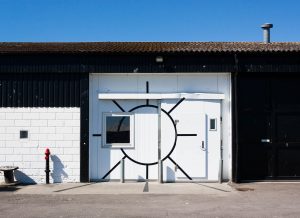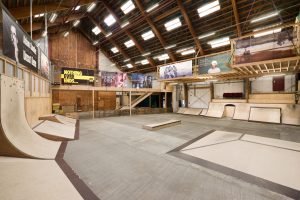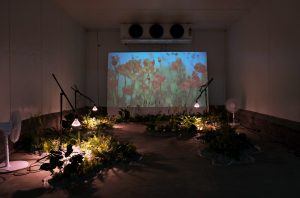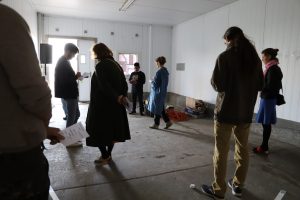Before, freshly caught fish lay side by side here in the fish auction's cold room. Today, the room at the harbor in Nexø is filled with new contemporary art from home and abroad.
The former cold room has been converted into the Sol exhibition site, which since 2019 has presented both the local Bornholm audience and visiting tourists with exhibitions that might not have found their way to the rocky island if it were not for the new space for contemporary art in Nexø.
Sol, who is among the nominees for BKF prize Artist-run Exhibition Places of the Year 2021, was founded by visual artist Sofie Amalie Andersen. When she moved to Bornholm in 2018, she discovered that the local scene for contemporary art was limited and that, especially in Nexø, where she lives, there weren't really any meeting places for those interested in art:

Exhibition center Sol. Neksø Harbour, Bornholm.
"In contrast to the arts and crafts field, which is massively represented and well organized on Bornholm, the visual arts field on the island is fragmentary and generally underrepresented. That's why I took the initiative to start an exhibition place where I could invite other artists to come and make exhibitions that were able to challenge the local environment and the many tourists coming. When I found the room at the harbor in Nexø, it seemed to me a perfect starting point for an artistic dialogue with Nexø's local environment and history," says Sofie Amalie Andersen.
Behind the Sol exhibition site today stands the association Sol Nexø, which in addition to the founder consists of a number of other artists, both local and resident elsewhere in Denmark and abroad. In 2019 and 2020, Sofie Amalie Andersen has had both a curating and organizing role, but this year she has invited visual artist Signe Boe to curate the main part of the exhibition program, while Sofie Amalie Andersen remains acting manager and organizer.
Art opens up new conversations
In this year's program, Sol has focused on creating concrete collaborations with local institutions and businesses, and one of the exhibitions that has greatly engaged local Neksø citizens is Jens Hüls Funder's GRACE PERIOD IS OVER, which took place in April.

Jens Hüls Finder: GRACE PERIOD IS OVER. Sun 2021.
The exhibition was divided into two places: In Sol's own room in the southern part of the harbor a series of works were installed, consisting of maple leaves sewn together with laces and mounted on the wall with Lego blocks. In the northern part of the harbor, at the skate and play center Værftet, Funder had created an installation in the large skate hall consisting of large banners printed with advertisements for commercial TV productions.
“The yard is run by a Christian association, and is popular among children and young people. In many ways, it was an unconventional but interesting collaboration that we got up to. Just as contemporary art can appear as a 'closed' space to many people, the religiously conditioned space can also appear hermetically sealed to outsiders. But Funder's exhibition created distance and closeness at the same time and initiated many questions about visual culture - and about the many codes and symbols that follow us in our daily lives," says Signe Boe.
Engaging the audience and creating new conversations are qualities that characterize Sol's exhibitions. This also applies, for example, to Kim Layborn's The conscious landscape (June/July 2020), where the artist i.a. created an installation consisting of concrete and plastic plants, fluorescent lamps and fans.

Kim Layborn: The conscious landscape. Sun 2020.
“The exhibition emitted a dystopian energy that made visitors reflect on issues surrounding nature and the environment. Not least seen in the light of Nexø harbour's own history, where the fishing industry, as a result of overfishing, pollution and trade quotas, suffered a serious setback in the 90s. The exhibition touched many people who were eager to talk further about environment and climate issues. But there were also many, both children and adults, who experienced the exhibition as a playful and endearing space in its immediate form," says Sofie Amalie Andersen.
Fine art for a wide audience
Artists' self-organised projects play a decisive role in the development of art as a whole, because they are driven solely by artistic necessity, Sofie Amalie Andersen and Signe Boe believe.
"Artist-run exhibition venues offer alternatives to the established institutions and can break with conforming economic, political and aesthetic trends. At Sol, we have chosen to organize ourselves in a way where we are 100% non-commercial, but on the other hand we are dependent on support from various foundations. It gives a freedom in terms of separating the operation of the exhibition venue from our private artist finances - but in return, foundation funds bring with them a number of demands on accessibility and visibility, which can sometimes seem difficult to achieve," says Sofie Amalie Andersen and elaborates:
“Getting a wider public to take an interest in narrow contemporary art is not easy. But at the same time, it is not sustainable to insist on producing exhibitions, which cost time and money, for a small number of the population. This is a dilemma we live with, and we try to balance the exhibitions in the best possible way, so that they are open and interesting to as many people as possible, without in any way compromising the artistic integrity.”

SUN FESTIVAL. Exhibition with contributions by Peter Voss-Knude, Marie Rafn, Alexander Brix Tillegreen, Ragnhild May, Majse Vilstrup, Signe Boe and Sofie Amalie Andersen. Sun 2020.
Developing contribution to professional conversation
"Because there are not that many galleries or other exhibition venues on Bornholm that offer diverse, high-quality contemporary art, we have set up and communicate in a way that is somewhat reminiscent of the more established institutions - because we passionately want to lobby for the art area locally . But we have also learned that there are big differences between us and the institutions, first and foremost because we ourselves are artists with our own careers to look after."
"Most of all, we want the freedom to test artistic boundaries. What we may miss, both as visual artists and in the curatorial role, is a critical conversation about the exhibitions, and there would be a better breeding ground for that if we all started to see the exhibitions in the artist-run places as a developing contribution to a professional discussion.”
If you ask Sofie Amalie Andersen and Signe Boe what could improve the conditions for artist-run places, they have both general and completely impractical suggestions for answers:
"On a very general - and utopian - level, there should be more education in art, more mention of art, more support for art in Denmark, so that more people, also in the province, could take advantage of the many exciting artistically driven initiatives around the country ,” says Signe Boe. Sofie Amalie Andersen adds:
"On a very specific level, it would help if, for example, the support schemes from the Statens Kunstfond, e.g. the 1-year exhibition programme, had more deadlines than just one yearly. It is important to recognize that artist-run exhibition spaces are flexible sizes, and that this is where their greatest potential lies.”

SUN FESTIVAL. Exhibition with contributions by Peter Voss-Knude, Marie Rafn, Alexander Brix Tillegreen, Ragnhild May, Majse Vilstrup, Signe Boe and Sofie Amalie Andersen. Sun 2020.